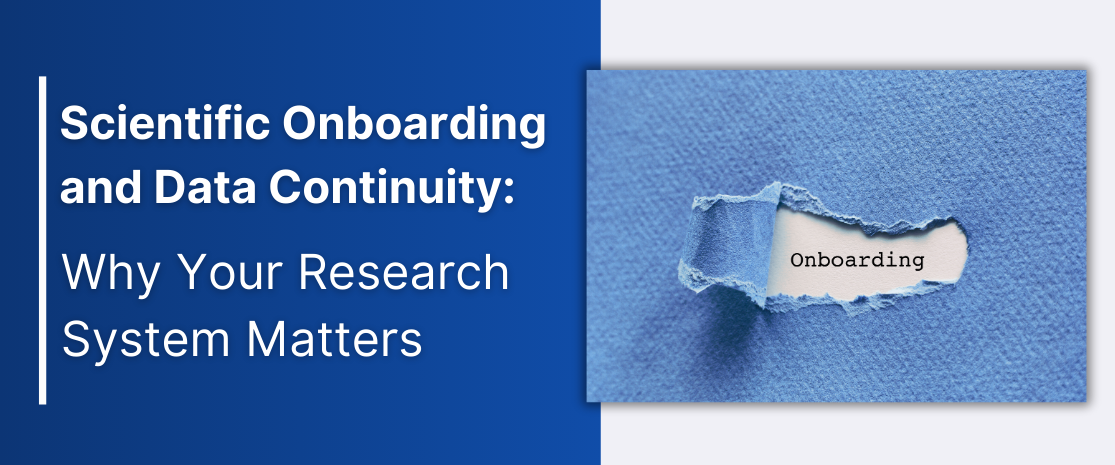Scientific Onboarding and Data Continuity: Why Your Research System Matters
![]() 4 min read
4 min read
Onboarding Isn’t Just HR — It’s a Research Continuity Challenge
Implementing any new system in a research environment is rarely just a technical matter. Scientific labs in biopharma, diagnostics, and MedTech depend on structured, repeatable knowledge transfer to ensure discovery doesn’t stall as teams grow or change.
Yet for many organizations, onboarding is still treated like a checklist. New scientists are welcomed and given access to folders, spreadsheets, team chats, but not to systematized knowledge. The result? Data gets lost in silos, expertise walks out the door, and productivity suffers quietly.
This post explores the hidden cost of unstructured onboarding and shows how science-led teams are reframing onboarding as a data continuity and workflow efficiency challenge.
Early Signs of Disconnected Onboarding in R&D Labs
One of the first challenges new lab members face is a surprisingly basic one: Where is the information I need?
Even when legacy work is stored in shared folders or spreadsheets, essential context is often missing. File naming conventions vary, version history is unclear, and new scientists can end up spending more time searching for protocols than contributing to them. It’s not that the data is gone, but its visibility is functionally lost. Without a structured, searchable system that connects protocols, data files, sample records, and task history, information doesn’t scale beyond the person who created it.
This disconnect shows up in many ways across scientific teams in fast-paced industries:
- Difficulty locating previous research data
- Uncertainty about file or protocol version status
- Re-running experiments unintentionally
- Inconsistent handoffs between departments or sites
These problems aren’t just operational frustrations, they can delay critical stages of the R&D lifecycle, slowing down discovery, validation, and scale-up.
The Real Cost of Lost or Duplicated Data in Research Environments
When experimental results or protocols are hard to find, researchers recreate work already completed. This doesn’t merely cost time. It undermines R&D continuity, wastes consumables, and reduces the quality of evidence trails required for clinical, regulatory, or tech transfer documentation.
Poor onboarding contributes up to 33% of new hires leaving within 90 days, and replacing someone can cost up to 200% of their salary. Adding the cost of delayed experiments, missed deadlines, or lost knowledge, the price can stack up irreparably.
Solving this problem doesn’t require a complete reinvention of a lab. But it does require a rethink of how the data is stored, shared, and surfaced. It requires an introduction of an operational system that treats scientific data like something worth protecting, not just something worth collecting.
That system might be an Electronic Lab Notebook, a LIMS, or similar scientific lab management system, but verified case studies show notable improvements after such structured onboarding and scientific data access systems are introduced:
- Labs cut onboarding time from three weeks to three days
- Some report saving 17+ hours per scientist per week through better data visibility
- Up to 25% more efficiency gained in documentation workflows
Multiply the hours/days saved by the number of scientists on the team, to assess the financial impact the introduction of a lab management system like ELN or LIMS has.
For organizations in tightly regulated environments like medical diagnostics or biologics R&D, these incremental gains drive higher output, fewer bottlenecks, and stronger compliance support.
Structuring Data for Advanced Research and Development
Effective onboarding depends on having past work that is accurate and easy to access. But in many R&D teams, unclear handoffs and version mix-ups create major challenges.
When QA, R&D, or compliance teams share work across locations or systems, documentation often doesn’t line up. QA leads may find that protocol versions don’t match reports. New team members waste time figuring out which trial run is the latest. Even well-organized shared folders can’t keep everything consistent.
That’s why leading labs use Electronic Lab Notebooks (ELNs) or Laboratory Information Management Systems (LIMS). These tools make it possible to:
- All experiments are linked to the original protocol
- Data is version-controlled and timestamped
- Inventory items, samples, and results are traceable and searchable
- Research documentation supports audit readiness without extra effort
By standardizing workflows and building search and traceability into the system, teams remove ambiguity, improve handoffs, and keep projects moving smoothly from discovery to validation to QA, without relying on memory or guesswork.
Operational strategy: Reduce R&D Risk, Increase Visibility
From a leadership standpoint, onboarding isn’t just about welcoming new team members, it directly impacts broader strategic goals. Effective onboarding maximizes early productivity, reduces variation in experimental processes, enforces documentation standards, and improves visibility across sites and teams. Strong onboarding practices also translate into better outcomes in clinical readiness, pre-clinical validation, and internal product development sprints.
Solving this challenge doesn’t require reinventing scientific workflows, but it does require treating onboarding as an operational process and a data infrastructure priority. High-performing organizations implement systems that:
- Link experiments to originating protocols
- Keep past data structured, searchable, and versioned
- Map inventory and results directly to projects
- Provide training and SOP access without personal handoffs
Modern labs are adopting Electronic Lab Notebooks (ELNs) and Laboratory Information Management Systems (LIMS) to ensure continuity, traceability, and collaboration from day one, while staying prepared for regulatory audits and cross-team handoffs.
Final Consideration: Information That’s Hard to Find Is Functionally Lost
Even if research data is stored, if it’s unsearchable or inaccessible, it may as well be lost. Without structured onboarding and version traceability, scientists rerun studies, documentation fragments across teams, and institutional knowledge erodes with staff turnover.
Whether you’re leading a single lab or managing operations across an entire R&D department, formalizing onboarding protects research, accelerates productivity, and reduces risk.
- Structure matters: Visibility and version control turn past work into usable knowledge.
- Trust matters: Scientists must trust that the data they find is the data they can use.
- Continuity matters: When staff transitions occur, systems—not people—should preserve knowledge.
Structured onboarding and research data continuity aren’t “nice to haves”; they’re the foundation for innovation at scale in Biotech, MedTech, and Life Sciences organizations. When onboarding is aligned with data infrastructure, new hires contribute faster, existing work retains its value, and science moves forward with confidence.

Don’t let your next breakthrough be delayed by data you already have.
Structured onboarding turns every experiment into a lasting asset, so your next hire doesn’t waste time rediscovering what’s already been done. The real cost of delays is knowing the answers existed but were buried.




